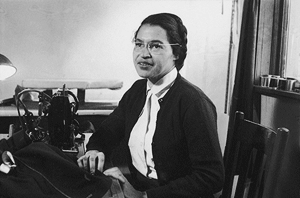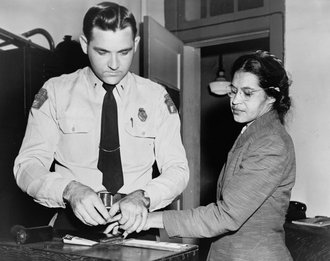Rosa Parks: Civil Rights Pioneer
Rosa Parks is an example of how the actions of one person can start a chain reaction of events that has far-reaching results. Her refusal to give up her seat on a city bus inspired other African-Americans to demand better treatment in all areas of their lives. She was a reluctant hero, and probably not all of the things that "everyone knows" about her are true. Nonetheless, she remains a powerful symbol of how one person can make a difference. She was born on February 4, 1913, in Tuskegee, Alabama, in the heart of the American South, at a time when African-Americans were considered second-place citizens in many parts of the country. She was educated at home by her mother, a teacher, until she moved to Montgomery to live with an aunt. In Montgomery, she enrolled in the Industrial School for Girls, a private school; to pay for this school, she cleaned classrooms. As an older child, she attended Booker T. Washington High School. She left before she graduated, however, to take care of her mother, who was very ill. In 1932, when she was 19, Rosa married Raymond Parks. Two years later, she returned to school and got her high school dipoloma.
She started working in the 1950s for the National Association for the Advancement of Colored People (NAACP), as a secretary in the Montgomery, Alabama, branch office. It was in Montgomery, on December 1, 1955, that she made history. In those days, Montgomery, like other cities in Alabama and across the South, had a series of laws designed to reinforce the idea that white Americans and African-Americans should remain separate. One of these stated that on the city buses of Montgomery, African-Americans were required to sit in the back of the bus. White Americans could sit anywhere, not just in the front of the bus. The laws also stated that African-Americans should give up their seats if a white person wanted to sit down. This is what happened to Rosa Parks. She was sitting where the law said she should have been sitting: in the back of the bus. She was tired from working all day, and she was tired of being made to feel inferior simply because of her skin color. So on this day, when a white man found the "white" section of this particular Montgomery city bus full and moved to the "colored" section, he appealed to the bus driver, who ordered Rosa and three other people to give up their seats and stand up so this man could sit down. The other She was arrested for breaking the city bus law and spent a night in jail. She was tried and convicted of disorderly conduct. She was fined $14. Her lawyer promised to appeal the conviction. Next page > Later Life and Fame > Page 1, 2 |
|
Social Studies for Kids
copyright 2002–2026
David White

 She worked as a department store seamstress, making and altering clothes. It was a job that she would do for most of her life.
She worked as a department store seamstress, making and altering clothes. It was a job that she would do for most of her life. people moved, but Rosa did not. She stayed seated. She was clearly breaking the law, and she knew it. The law, however, was unjust, she thought.
people moved, but Rosa did not. She stayed seated. She was clearly breaking the law, and she knew it. The law, however, was unjust, she thought.
